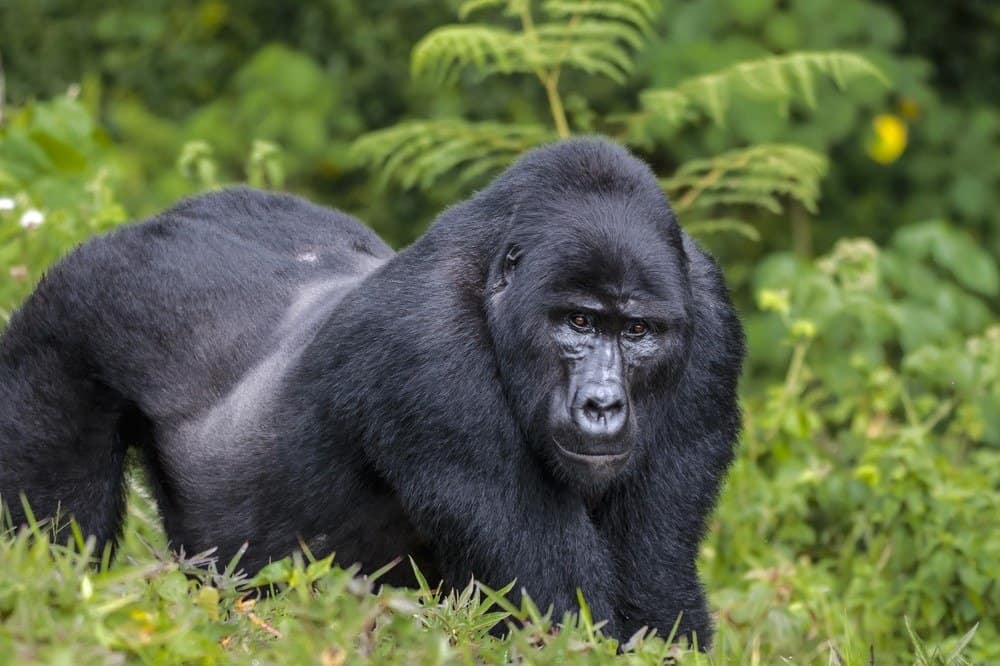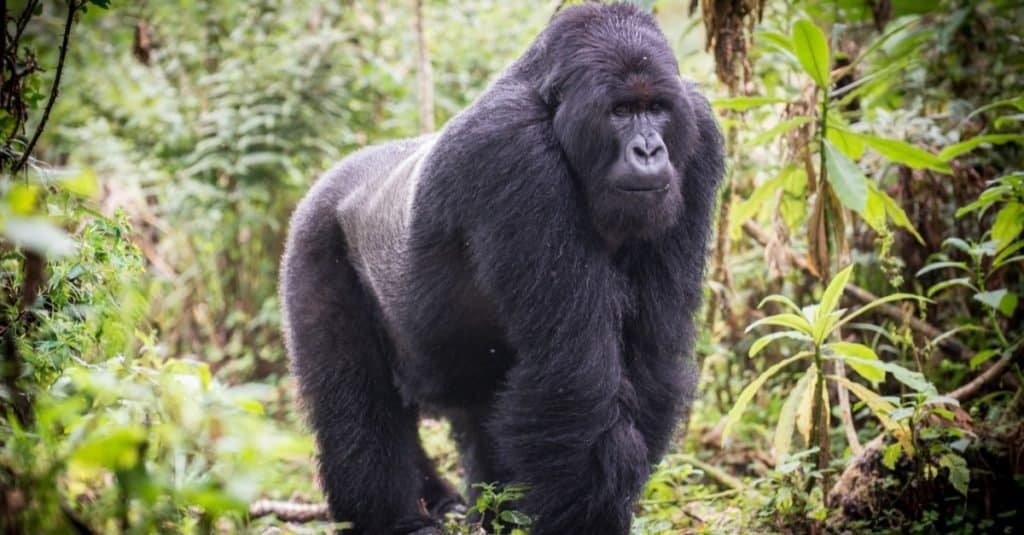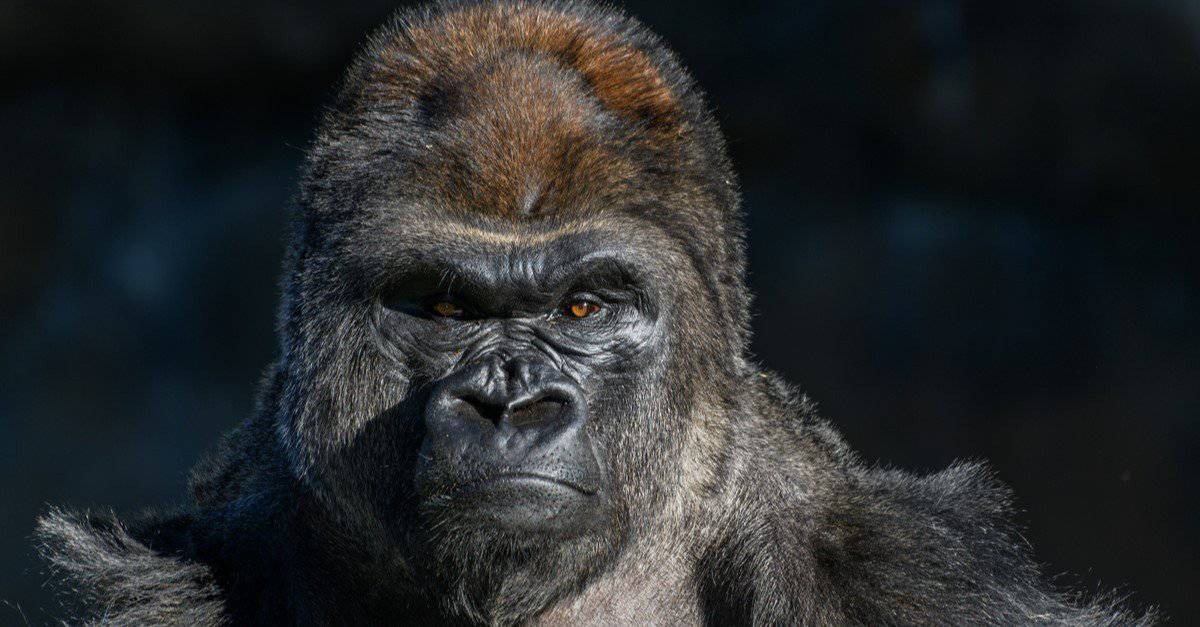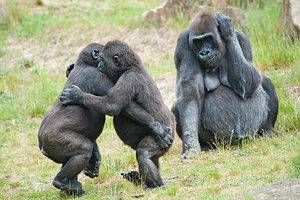Gorillas are the largest apes around and have been on Earth for approximately 7 million years. These huge mammals are usually found in forests and mountain regions and are easily distinguished by their large size and thick black hair. Gorillas are closely related to humans and have a lifespan of 40 to 50 years, although some have been known to live for far longer.
But just how old is the oldest gorilla ever? We’ll discover the oldest gorilla alive today and see how they compare against the lifespans of other primates.
What Types of Gorillas Are There and Where Do They Live?

Silverback male gorilla
©Krasnova Ekaterina/Shutterstock.com
There are two species of gorilla – eastern and western – and each have two subspecies. The subspecies of eastern gorillas are mountain gorillas and eastern lowland gorillas, while the subspecies of western gorillas are Cross River gorillas and western lowland gorillas. Eastern gorillas are slightly bigger than western gorillas. The eastern lowland is the largest subspecies, and the western lowland is the smallest subspecies.
Gorillas are native to Africa, and where they are found depends on which subspecies they are. Eastern lowland gorillas – the largest – are endemic to the lowland rainforests of the Democratic Republic of Congo and males weigh around 450 pounds. Mountain gorillas live between 8,000 and 13,000 feet in the mountains of several national parks – Mhahinga and Bwindi national parks in Uganda, Volcanoes national park in Rwanda, and Virunga in the Democratic Republic of Congo and males weigh around 400 pounds.
The Cross River gorillas are found only in the rainforests of the Cameroon – Nigeria border around the Cross River, and weigh around 400 pounds. The western lowland gorillas are found in forests and swampland in Angola, Cameroon, the Central African Republic, Republic of the Congo, Equatorial Guinea, and Gabon, and males weigh around 390 pounds.
There are some slight differences in appearance between the four subspecies, although they all have a generally similar appearance. Mountain gorillas usually have thicker hair to keep them warm in sub-zero temperatures in the mountains and a bony crest on the top and back of their skull which gives their heads a more colonial shape. All adult male gorillas have silver grey hair on their back and rumps, hence why they are usually called “silverbacks”. Silverbacks are usually the biggest gorillas and some can reach more than 6 feet tall when standing upright.
The Oldest Gorilla Ever

The oldest gorillas alive today are western lowland gorillas
©Andreas Rose/Shutterstock.com
The oldest gorilla ever is currently 64 years old. Fatou is a western lowland gorilla and lives at Berlin Zoo. She was born in the wild in 1957 and brought to France by a sailor in 1959 before she was sent to Berlin Zoo where she has lived ever since. She had one daughter, called Dufte, and has many grandchildren and great grandchildren. In April 2021 she celebrated her birthday with a special treat of fruit, vegetables, eggs, and rice cakes provided by the zookeepers to mark the occasion.
Gorillas in captivity tend to live longer than gorillas in the wild, and the previous oldest gorilla was Trudy, who was also a western lowland gorilla. Trudy was born in the wild in 1956 and died in 2019 aged 63 years in Little Rock Zoo in Arkansas in the US. There is also another gorilla alive currently who is one of the oldest at 63 years old. Helen was born in 1958 and lives in Louisville Zoo in the US.
Gorillas vs. The Oldest Apes on Record

Gorillas live longer than most other primates
©Jurgen Vogt/Shutterstock.com
Compared to orangutans, gorillas seem to live slightly longer. The oldest orangutan alive today is 60 years old and the oldest ever died in 2018 aged 62 years. Gorillas also live longer than monkeys as the oldest monkey recorded was 54 years old. The average lifespan of a monkey is around 30 to 40 years, depending on the species.
However, chimpanzees have lived for longer than gorillas. The oldest chimpanzee was 79 when she died and there have been several others live for more than 65 years.
Behavior and Social Hierarchy of Gorillas

Gorillas nurse for almost 3 years
©Asaf Weizman/Shutterstock.com
Most gorillas are herbivores and eat stems, bamboo shoots, and fruit. However, western lowland gorillas also eat ants and termites, and break open termite nests to eat the larvae.
One of the most amazing things about gorillas is that every night each gorilla makes a new nest in the vegetation to sleep in. They usually sleep alone, although infants will sleep with their mothers.
Gorillas live in troops of between around 30 animals, although the Cross River gorillas live in the smallest groups, and the silverback is always dominant. Gorillas don’t become mature until they are 10 years old and usually only the silverback will mate with the females. Gestation lasts for 8.5 months and females give birth to one baby approximately every four to six years. Infants are in constant contact with their mother for the first six months of their lives and they nurse for almost three years.
Gorillas are usually very peaceful animals and the range of one group often overlaps into the range belonging to another group. The females especially are usually very calm and often groom the silverback. Males usually leave the group they were born in once they reach sexual maturity to avoid conflict with the silverback, and it’s not uncommon for several males to form “bachelor groups”. Sometimes females with young might leave the group to prevent the silverback eventually interbreeding with their daughters.
When the silverback dies another will take his place and sometimes this might be one of his sons who has remained in the group. If there is no replacement, then the females will adopt a new silverback into the group. However, when a new silverback takes over he will usually kill all of the existing infants to create more mating opportunities for himself.
Conservation: Are Gorillas Under Threat?

Cross River gorillas are the rarest great apes in the world
©Kit Korzun/Shutterstock.com
All four subspecies are considered to be under threat – mountain gorillas are classed as being endangered, while the other three subspecies are critically endangered. The Cross River gorillas are the most under threat and are the rarest great ape in the world, with an estimated less that 250 mature Cross River gorillas left in the world today.
Although the only natural predators of gorillas are leopards and crocodiles, their biggest threat is considered to be us humans, and a combination of habitat loss, disease, and poaching has taken its toll on their numbers.
Habitat loss is caused by mining, logging, and agriculture and the available range for the gorillas has considerably declined. In addition, civil unrest in the regions where the gorillas live has resulted in many forest areas being used as a retreat for opposition groups and has further reduced their habitat.
Thank you for reading! Have some feedback for us? Contact the AZ Animals editorial team.







